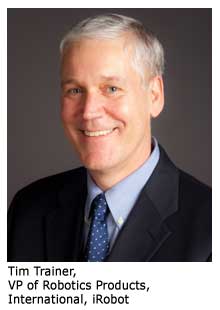Combining the volatile and unpredictable nature of large-scale events, security service providers must keep an eye out for all signs of looming danger and potential risks in all areas of and within the vicinities of the event.
The recent spike in threats at large-scale events such as the terrorist bombing at the Boston Marathon, the violent double murder at the Confederations Cup in Brazil, and the bomb discovered in the bathroom near the proximity of a shrine in S?o Paulo prior to Pope Francis' scheduled visit is emphasizing the dire need of high security at large-scale events. Surveillance has always been an excruciatingly important aspect of ensuring security. Robots, drones, tethered balloons – previously strictly limited to military usage, advanced surveillance technologies are increasingly being deployed at large-scale events. Different methods of surveillance are also being reinvented to address pre-existing issues such as providing full and clear coverage in a widely spanned area.
Fixed Surveillance
Traditional surveillance in large-scale events are comprised of mostly fixed dome or box cameras; however, they are not suitable for monitoring expansive areas because they are not equipped with optical zoom, which contributes to why a lot of PTZ cameras are currently being used. Though PTZ is useful in such cases, they can only record what the operator is watching live. If the operator decides to zoom in on, let's say, the top right corner of the field, that will be the only scene recorded. Innovative technologies have since been developed to tackle this issue. Dallmeier recently unveiled its “multifocal sensor camera system capable of monitoring a large area from a single location in an efficient manner, while permanently recording the overall scene with highest detail resolution,” according to Roland Meier, Head of Panomera Technology at Dallmeier. “The system encompasses several lenses with different focal lengths to ‘slice up' the scene so each area has the optimum focal length assigned to it. With this system, individuals are clearly recognizable even at distances of more than 160 meters.” This essentially means faces of audience, objects, etc. in the background will be as clear as those in the foreground, increasing the chances for face recognition software to establish a match or abnormal activities and objects to be registered by video analytics.
With video surveillance covering the grounds and perimeters, both inside and outside of the facility, it is imperative to have an open VMS platform that can be integrated through SDKs and supports all features of the cameras. “This allows new applications to be integrated with the video surveillance, whether it is new cameras, analytics, access control, lighting or other building management, traffic monitoring, people counting, etc. Customers can opt for the application they want, able to work with the same VMS platform – without the need to scrap the whole system and start from scratch,” said Sunny Kong, Director of Sales, Asia at Milestone Systems.
While VMS can provide security providers with situational awareness, PSIM is an all encompassing solution that not only provides situational awareness, but event management as well. PSIM acts as a platform that enables users to efficiently leverage people and technology to manage occurring incidents. If something were to occur, the PSIM will set off a chain of actions to address the situation.

Mobile Surveillance
Having extra surveillance around the vicinity is always a good thing, yet they must be strategically positioned to serve their purposes. Hence, having surveillance cameras that can physically move – not just the regular pan, tilt, and zoom – to designated areas not only decrease the number of cameras needed, but provide a more complete view of the targeted areas.
 Eyes on Wheels
Eyes on Wheels
Mobile surveillance trailers are easily deployed and customized for almost any type of event, such as being fitted with strobes, lights, sirens, and speakers to help disperse crowds or alert other security personnel in the area of any potential problems. Mobile surveillance trailers have been used in multiple large-scale events, such as the 2012 Africa Cup of Nations or the recent Calgary Stampede in Alberta, Canada. “The advantage of using the self-contained trailers would serve two main purposes. By having a large self-contained mobile trailer, you have the large presence of a security element that can be deployed to any area of concern. One mobile trailer can be fitted with multiple cameras giving an officer a much better view from above while scanning the crowds for suspicious activity,” said Guy Savage, Business Development Executive at Danner's Security.
Many exciting technologies are being developed for mobile security. Savage believes the future trends for mobile security will be dependent on the types of cameras used and built-in software analytics. “These mobile systems are also available to companies as an alternative to using fixed camera monitoring security. Contracting one security officer can range from US$5,000 to $8,500 a month vs. a camera monitoring system from $450 to $1,800 a month. Security personnel costs are high and although you can't always replace them in some instances, a professional, installed mobile or fixed camera solution can save law enforcement and businesses thousands of dollars,” said Savage.
 Robot Vision
Robot Vision
A step up from the mobile surveillance trailers are robots that will be deployed at large events. No longer reserved for military use, “iRobot recently received a $7.2 million order from the government of Brazil for 30 of the company's robots. These robots were procured specifically for the Extraordinary Secretariat for the Security of Great Events to be used in preparation of large-scale events happening in Brazil over the next several years, including the recently completed Confederations Cup, the Papal visit, and the upcoming World Cup and Olympic events. These robots will be used by the Federal Police and other local police forces throughout Brazil to provide public safety support during these major events and for other law enforcement applications moving forward,” explained Tim Trainer, VP of Robotics Products, International at iRobot. In large events, the robots can be used for several missions including the identification and disposal of potentially dangerous objects, to provide situational awareness in a potentially dangerous environment, and to communicate with someone in a hard to reach area.
“Our mesh radio capability allows multiple robots to interact, thereby extending the communication ranges in difficult, non line-of-sight urban environments. Semi-autonomous features like self-righting and retro-traverse allow the robots to operate more independently, allowing operators to focus attention on situational awareness and more critical tasks,” stated Trainer.
Aerial Surveillance
Several mega sports events have started to employ aerial surveillance such as the 2010 Commonwealth Games in New Delhi, 2010 Winter Olympics and Paralympics in Vancouver, and 2012 London Olympics, and will be used for 2014 Sochi Winter Olympics. Having eyes in the sky can provide security staff and personnel an unobstructed and clearer picture of the grounds spanning for miles, something regular ground surveillance is unable to achieve.
View from Above
Aerostats are “ideal for use in the urban environments where conventional ground-based surveillance methods are rendered useless by domain obstructions such as buildings or landscape. TCOM aerostats are able to observe hundreds or even thousands of square miles at a time,” said Brian Tillman, PR Spokesperson for TCOM. “Since aerostats carry both surveillance and communications payloads, they not only aid in monitoring large-scale areas, they also improve connectivity and collaborative ability of security personnel by relaying communications information.” Just last year, aerostats have been deployed for both Madonna and Red Hot Chili Pepper concerts in Israel, the former with more than 30,000 viewers and latter with more than 51,000 viewers.
“In a situation such as the Olympics, World Cup, or Superbowl, the aerostat system is a smart investment for the host city. Not only does the system provide advanced persistent surveillance during the event, the aerostat system can be integrated into the host city's security infrastructure as a versatile, reliable tool to assist police and domestic security officers long after the event. For the host city, meaningful ROI will accrue over the years, even decades following the event,” Tillman continued.

Drone Perception
Previously, unmanned aerial vehicles (UAV), also known as drones, had only been used by military forces to gather intelligence and perform remote surveillance in dangerous areas, or industrial uses such as inspecting oil and gas pipelines. According to a market study conducted by Teal Group, “World Unmanned Aerial Vehicle Systems Market Profile and Forecast 2013”, the market will more than double by the end of the next decade from current worldwide UAV research and development and procurement expenditures of about $5.2 billion to $11.6 billion, totaling over $89 billion in the next decade. Based on the report, the U.S. is the largest market, APAC the second largest, followed by Europe, and Africa and Latin America are expected to be modest markets for UAVs.
After being enlisted by more law enforcement agencies around the world, drones are making increased appearances in large-scale events, including past Olympic events. These drones are smaller and more maneuverable than aerostats – comparable to a flying robot – and are operable in all weather conditions. The 2012 London Olympics employed drones from a UK company. The system was deployed at The Mall and Buckingham Palace to provide real time images to emergency services during the event via Wi-Fi. Law enforcement officers, security personnel, and emergency services were all able to see the live-streaming images at the site control room. Following the drone trend is the police of Dubai, who plan on using small drones to monitor soccer fans in the upcoming final match of the Etisalat Cup soccer tournament.
All things together, surveillance is a vital part of keeping any venue and facility safe and protected at large-scale events. That is also why many large-scale events are deploying surveillance of all kinds, whether they are on the grounds or in the sky. With the continuous advancements and integration of video surveillance into different shapes and forms, large-scale events can only become safer for the spectators, participants, and all others involved.